The video game console industry has a rich history that dates back to the early 1970s. Ever since the introduction of the first consoles, the gaming landscape has undergone a radical transformation, driven by technological innovation and an ever-growing appetite for immersive experiences. The market for gaming consoles has flourished, with hundreds of millions of units sold globally. This proliferation of consoles has given rise to gaming juggernauts, including franchise staples like “Assassin’s Creed” and “Zelda.” Collectively, the top five gaming consoles have reached astonishing sales numbers, with about 700 million units sold between them.
Sony’s PlayStation 2 (PS2), launched in 2000, became one of the most iconic consoles in history. Its release was met with unparalleled enthusiasm, exemplified by the chaos of midnight launches across the United States. Players were not just eagerly awaiting the console; they were obsessed with securing their place in line. One of the PS2’s initial key features was its backward compatibility, allowing gamers to play their beloved original PlayStation titles. The ability to watch DVDs also provided it with a unique selling proposition, marking a significant step towards integrating entertainment and gaming.
Despite initial skepticism regarding its game lineup, the PS2 thrived due to a wave of blockbuster titles. Essential gaming franchises like “Grand Theft Auto,” “Final Fantasy,” and “Metal Gear Solid” catapulted the console to record sales. Former CEO of Sony Interactive Entertainment, Jim Ryan, indicated that PS2 sales could be around 160 million units, a testament to its remarkable legacy.
Nintendo has always been at the forefront of gaming innovation, as demonstrated by the release of the Nintendo DS in the mid-2000s. Its dual-screen design, complete with a touchscreen interface and built-in microphone, revolutionized the gaming experience. Building on the success of the Game Boy, the DS provided a platform that appealed to both casual and hardcore gamers. Titles like “Mario,” “Zelda,” and “Pokemon” became keystones of this platform, while innovative games like “Nintendogs” created new gaming niches.
Following the DS, the Nintendo Switch emerged in 2017. Its hybrid design allowed players to seamlessly transition from handheld to traditional console gaming, tapping into the growing demand for portable gaming solutions without sacrificing depth. The Switch quickly gained traction and became synonymous with games like “Animal Crossing: New Horizons,” which saw a dramatic surge in popularity during the COVID-19 pandemic, striking a chord with players navigating confinement.
Another console that has had an enduring impact is the original Game Boy. Launched in the late 1980s, it became a cultural touchstone in the 1990s and early 2000s. The Game Boy introduced iconic characters like Pikachu from the Pokémon franchise, which emerged alongside a slew of other remarkable titles, such as “Tetris” and “Super Mario Land.” Its innovative design made it accessible and appealing, establishing Nintendo as a dominant player in the gaming market.
The Game Boy recorded over 118 million units sold, showcasing its undeniable influence on generations of gamers. Its simplicity combined with an array of captivating games paved the way for the next wave of handheld gaming consoles.
The competition in the gaming console market heated up again in the next generation. The PlayStation 4 (PS4), released in 2013, faced off against Microsoft’s Xbox series. With a strong library of critically acclaimed games, including titles from the “Grand Theft Auto” and “The Last of Us” franchises, the PS4 solidified its position by selling a staggering 117 million units. It not only emerged victorious in sales but also amassed a dedicated fan base drawn in by its game quality and developer support.
The evolution of video game consoles reflects broader trends in technology and media consumption. The industry’s leading figures—Sony and Nintendo—have shown remarkable adaptability and innovation, consistently reshaping the gaming experience. As new technologies emerge and players seek novel forms of engagement, the future of gaming promises to be as dynamic and exciting as its colorful past.


Leave a Reply